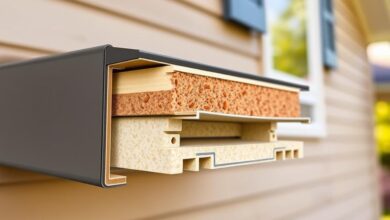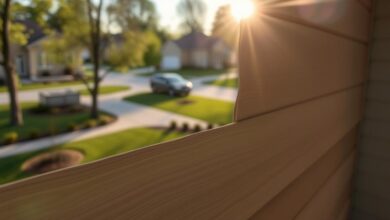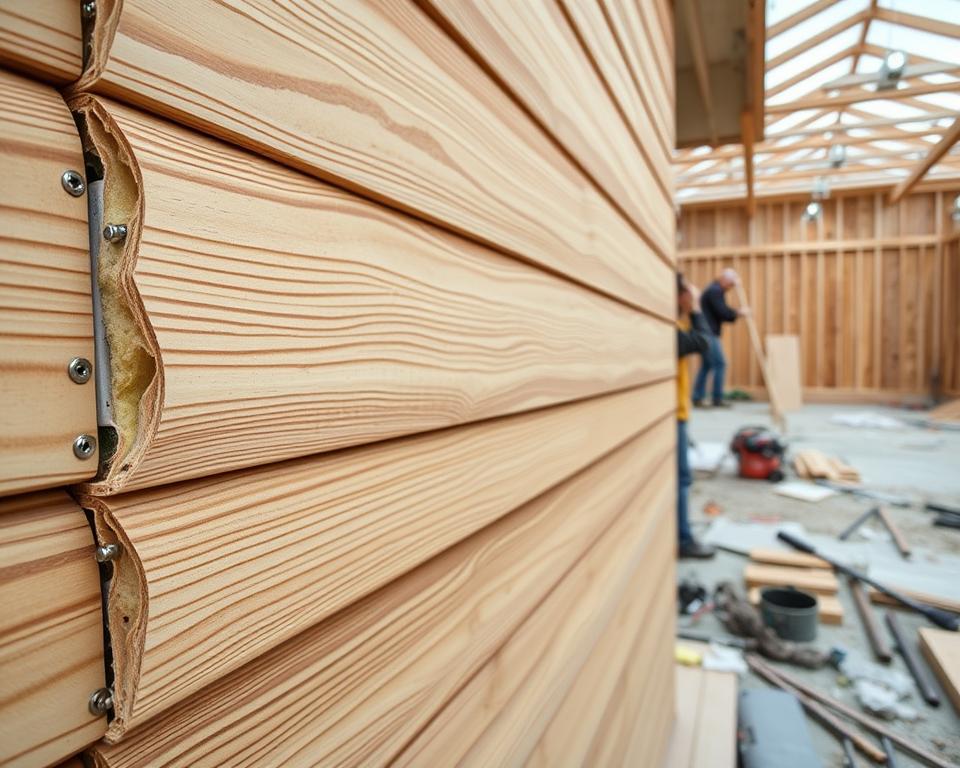Improve Home Insulation with Insulated Siding
Homeowners are always searching for ways to make their homes more energy efficient and cut down on utility bills. Installing insulated siding is a smart choice. It not only boosts home insulation but also makes living spaces more comfortable.
Insulated siding acts as a shield against harsh temperatures. It keeps homes cozy in winter and cool in summer. This reduces the need for heating and cooling, saving energy and lowering bills.
Choosing insulated siding means a more comfortable home and lower energy costs. It’s a smart, efficient way to enhance insulation and make homes greener.
Key Takeaways
- Insulated siding enhances home insulation and energy efficiency.
- It helps reduce utility bills by minimizing heat transfer.
- Homeowners can enjoy a more comfortable living space.
- It’s a practical solution for making homes more sustainable.
- Insulated siding can boost the overall value of the property.
Understanding Insulated Siding and Its Benefits
Insulated siding is a big win for homeowners wanting to save on energy. It looks great and works well, too.
What Is Insulated Siding?
Insulated siding wraps your home in a layer of foam plastic insulation. This foam is between the outside finish and the home’s sheathing. It stops heat from moving in and out, keeping your home cozy.
How Insulated Siding Differs from Traditional Siding
Insulated siding is more than just a shield against the weather. It’s got foam that keeps heat from escaping. Traditional siding, like vinyl or wood, doesn’t do this as well. So, insulated siding is better for saving energy.
Energy Efficiency Advantages
Insulated siding saves a lot on energy bills. It cuts down on how much heat escapes or enters your home. Studies show homes with it use less energy, saving money and keeping you comfy.
| Feature | Insulated Siding | Traditional Siding |
|---|---|---|
| Insulation Layer | Yes | No |
| Energy Efficiency | High | Low |
| Thermal Bridging | Minimized | Not Minimized |
Insulated Siding for Better Insulation: How It Works
It’s important to know how insulated siding works to understand its benefits. It’s made to block outside temperatures. This keeps homes warm in winter and cool in summer.
The Science Behind Insulated Siding
Insulated siding has foam plastic on the back. This makes the home’s exterior more efficient. It stops heat from moving in and out, saving energy.
R-Value Explained
The R-value shows how well insulation works. A higher R-value means better insulation. This leads to lower energy bills by keeping heat in and out.
“A higher R-value means better insulation, and that’s a key factor in choosing the right insulated siding for your home.”
Thermal Bridging Prevention
Insulated siding stops thermal bridging. This is when heat escapes through siding and framing. It covers the home fully, keeping it warm or cool.
Noise Reduction and Additional Benefits
Insulated siding also cuts down on noise. It makes homes quieter. Plus, it makes homes last longer and need less upkeep.
“By investing in insulated siding, homeowners can enjoy a more comfortable, quieter, and energy-efficient home.”
Choosing the Right Insulated Siding for Your Home
Homeowners have many insulated siding options to choose from. It’s important to think about different materials and their benefits and drawbacks. You should also consider the cost, how long it lasts, and how easy it is to maintain.
Types of Insulated Siding Materials
Insulated siding is made from various materials, each with its own strengths. Knowing these differences helps you make the best choice.
Vinyl Insulated Siding
Vinyl insulated siding is durable and easy to care for. It resists pests and can handle tough weather. It’s also affordable and comes in many styles and colors.
Fiber Cement Insulated Options
Fiber cement siding is strong and resists fire and pests. It’s made from cement, sand, and cellulose fibers. This siding looks like wood but doesn’t need the upkeep.
Foam Backing Variations
Foam backing is found in many insulated siding products. It adds extra insulation and can lower energy costs. The foam’s thickness and type affect its performance.
Factors to Consider When Selecting Insulated Siding
When picking insulated siding, think about your area’s climate, your home’s style, and your budget. Also, consider the long-term benefits and how it might increase your home’s value.
A leading expert says, “Choosing the right insulated siding material and ensuring proper installation are key to getting the most benefits.”
This highlights the need for careful planning and proper installation.
Cost Considerations and ROI
The cost of insulated siding varies based on the material and installation. It might cost more at first, but it can save you money on energy bills in the long run. Think about the return on investment when comparing siding options.
Finding Qualified Contractors
After choosing the right siding, find a skilled contractor for the installation. Look for contractors with experience in insulated siding and check their references. Proper installation is key to getting the most out of your siding.
By carefully choosing and working with a trusted contractor, you can enjoy the many benefits of insulated siding.
Installation Process and Best Practices
To get the most out of insulated siding, a careful installation is vital. This makes sure the siding works well, saving energy and lasting longer.
Preparing Your Home for Installation
Before starting, your home needs to be ready. Look for any damage or rot on the outside. Make sure the walls are strong and remove any old siding.
Key steps include:
- Checking for and repairing any damaged or rotten wood
- Ensuring all walls are secure and level
- Removing old siding and disposing of it properly
Step-by-Step Installation Guide
Installing insulated siding needs focus and care. Here’s a simple guide to follow.
Removing Old Siding
Start by taking off the old siding. Do this carefully to not harm the walls underneath.
Wall Preparation and Moisture Barriers
Next, get the walls ready. Check for moisture and put in a barrier if needed.
Proper Insulated Panel Installation
Then, put in the insulated panels. Make sure they’re fastened well and straight.
Common Installation Mistakes to Avoid
Staying away from common mistakes is important. Don’t mess up the alignment, fasten too little, or ignore moisture.
Maintenance Tips for Long-Lasting Performance
To keep your siding in top shape, regular care is essential. Clean it often, check for damage, and fix any issues quickly.
Seasonal Considerations
Think about the weather when you install. Extreme weather can impact the siding’s performance and installation.
Conclusion
Insulated siding is a great choice for homeowners wanting to make their homes more energy-efficient. It offers many benefits and works well to keep your home comfortable. By learning about insulated siding, you can decide if it’s right for your home.
Insulated siding saves energy by keeping your home warm in winter and cool in summer. This means lower energy bills and a more comfortable home. You can pick from different materials to fit your needs and budget.
Choosing insulated siding also helps the environment. It’s a smart move for your home and the planet. Make sure to hire skilled contractors for the best results.








